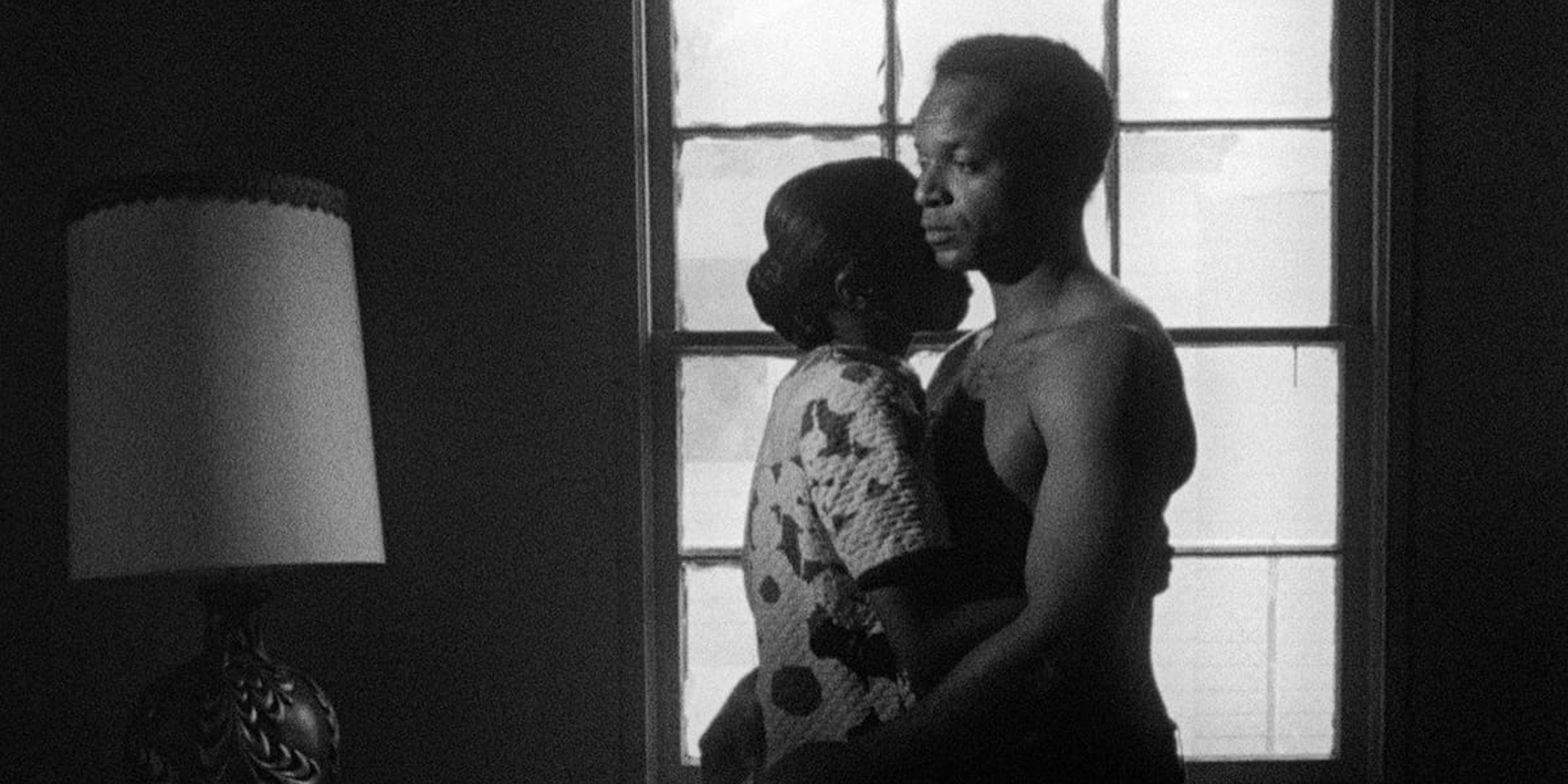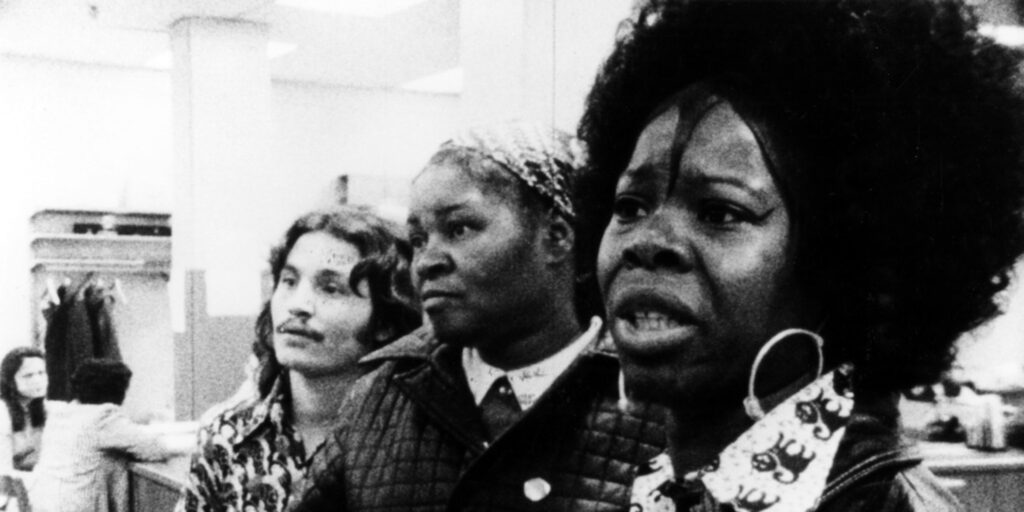There’s a moment in writer-director Charles Burnett’s astonishing 1978 debut, Killer of Sheep, that I have never stopped thinking about in the 18 years since I first encountered the film. Stan (Henry G. Sanders), a beleaguered Black slaughterhouse worker living in the Watts neighborhood of South Los Angeles, has just purchased a rusty, broken-down car engine. He and his friend Bracy (Charles Bracy) negotiate the heavy and unwieldy hunk of metal down several flights of stairs outside the seller’s house. It’s a scene as armrest-clenching as any glossy Hollywood thriller set-piece, which speaks to the humanistic magic of Burnett’s work. For a minute or two, watching two working-class guys carry a piece of junk down some stairs is the most riveting thing in the world.
With great effort, Stan and Bracy finally heave the engine into Stan’s truck, only for the filmmaker to hit his characters (and the audience) with the mother of all mordant punchlines. As the truck pulls away, the engine topples out of the truck bed and breaks. Although this whole sequence is wonderfully executed, the look of utter defeat on Stan’s face as he inspects the damage has been etched into my brain for almost two decades. As with much that occurs in the prismatic and loosely plotted Killer of Sheep, the specifics of Stan’s now-demolished ambitions for the engine are only roughly sketched, but the man’s dead-eyed expression tells the entire story. There’s no shock in this look, just a weary, soul-crushing despondence, hinting at a lifelong litany of similar setbacks. The moment is fleeting but profound. A pessimistic American viewer – Can there be any other kind at this point? – might describe “disappointed but not surprised” as our eternal national mood.
Burnett was born in Jim Crow Mississippi, but he grew up in Watts, a neighborhood with a substantial population of transplanted Black Southerners. One can sense a trace of this distinctive pedigree – a mingling of California hustle and Southern fatalism – in Killer of Sheep, which was shot in and around Watts, primarily in 1972-73. Burnett is a vital figure in what has retrospectively been dubbed the “LA Rebellion,” a current of filmmakers studying at UCLA in the 1960s-80s who pursued a vision for a new, independent Black cinema. Rather than classical Hollywood, Burnett and his contemporaries – including Larry Clark, Julie Dash, and Haile Gerima – looked to European art films and the emergent, revolutionary cinema of the Global South as their primary influences.
Critics have often compared Killer of Sheep to the neorealist masterworks of Italian director Vittorio De Sica (The Bicycle Thieves, Umberto D.), but the feature also reveals a filmmaker who has absorbed the works of the French New Wave, British kitchen-sink realism, and ethnographic documentaries from around the world. However, one needn’t be a film scholar to appreciate the astonishing power of Burnett’s film. It vibrates with the uncontainable energy of a sui generis masterpiece, tapping into something timeless and quintessential about the Black American experience – and American life in general. Unfortunately, partly due to rights issues with the soundtrack, the film lacked proper distribution for decades, restricting its admirers to a handful of dedicated cinephiles able to catch rare 16mm repertory screenings. Happily, the feature’s wider reputation grew following a restoration and re-release in 2007, and a new 4K restoration is currently making the rounds at art-film venues, further solidifying Killer of Sheep as a semi-lost, semi-rediscovered gem of American cinema.
Inasmuch as the film can be said to have a narrative, it is centered on Stan, who supports his wife (Kaycee Moore) and two children (Jack Drummond and Angela Burnett) by schlepping back and forth to a grueling job at the local sheep slaughterhouse. (Such employment might seem incongruous for an urban Angelino in the 1970s, but Watts notably started its life as a ranching and railroad town before its incorporation into LA.) Burnett presents the viewer with glimpses of this grim work, but the film’s title notwithstanding, the director’s attention is primarily focused elsewhere, on the (supposed) downtime between Stan’s long shifts. The director’s approach is sinewy and adaptive, smoothly switching between scripted vignettes such as the engine incident and more impressionistic imagery of daily life in Watts.
Stan is, in a word, a complicated man. Ground down by the miseries of poverty-wage manual labor and the day-to-day indignities of a racist society, he simmers with an exhausted bitterness. His pride is such that he rankles when someone suggests that he is poor – He’s a working man, isn’t he? He donates to the Salvation Army! – and providing for his family seems to be his highest priority. Yet that family also receives the brunt of his resentment. His demeanor toward his wife is erratic, veering between tenderness, harshness, and indifference. For her part, she is unafraid to express her discontent and vigilant for unsavory influences that might tempt her husband away from his responsibilities. In the film’s most devastatingly beautiful scene, the couple spontaneously slow dance in their darkened living room to Dinah Washington’s “Bitter Earth.” It’s a moment that is almost startling in its frank eroticism – Stan shirtless, his wife caressing him with increasing urgency – but the song eventually ends, and Stan abruptly pulls away.
Burnett consistently favors evocative texture over matters of story. The film provides little to no background for its cavalcade of anonymous neighborhood denizens: working stiffs, odd-jobbers, retirees, hustlers, pimps, gamblers, and gaggles of idly rambunctious children. There is a sense of authentic absurdity to the feature’s details that suggest the richness of its off-screen world. At the engine-seller’s apartment, an unfortunate fellow stretched out on the floor nurses his bloody injuries from a recent fight. Who beat him up and why? Burnett hints but never offers a clear explanation; it’s just one of those weird, random things you see every day in the ghetto, like the pair of small-time hoods caught hauling a (presumably) stolen television over a wooden fence. This is the post-riots Watts, a landscape of misguided and half-completed “urban renewal” projects that turned a walkable, working-class Black-majority neighborhood into a auto-centric wasteland of gang activity and violent crime.
Burnett isn’t above a little didacticism about the intra-tribal fissures within Black culture: In one pointed scene, Stan’s wife lays into a pair of criminal-coded associates who are haranguing her husband about his supposed deficient masculinity. Elsewhere, the filmmaker’s touch is lighter but no less provocative. When Stan drops by the local, white-owned convenience store, the proprietress pressures him with a job offer that carries a troubling whiff of sexual fetishism – which then mutates into garden-variety racist hostility. Burnett’s film feels at once inescapably political and calmly nonjudgmental. His dedication to an unsentimental depiction of urban Black life, warts and all, finds him juxtaposing microcosmic scripted sequences such as these with more observational, quasi-documentary imagery, often of children playing: chaotic rock fights in vacant lots, wobbly bike rides alongside local stray dogs, and boys leaping fearlessly across rooftop gaps. (The latter immortalized on the album cover of Mos Def’s 2009 studio LP, The Ecstatic.)
Cinephiles with a formal bent will doubtlessly find these vivid out-of-time moments a touch more compelling than the play-like scripted scenes in Burnett’s feature, in part due to shaky acting from his largely non-professional supporting cast. Yet the director weaves together his film’s elements with such intuitive verve and clarity of purpose, the cinematic whole still feels miraculously seamless. This is not a film about rising tension or dramatic conflicts. Indeed, one could scramble the chronology of the scripted scenes and nothing would really change, underlining the despairing sensation that Stan is running to stand still: Some things happen to him, then some other things, but the sheep never stop lining up for the slaughter. Like all of us, Stan and his wife probably once imagined a better, different existence for themselves, but life – not to mention the roadblocks engineered by a racist socioeconomic system – got in the way.
Burnett has never made another film quite like his debut feature, although his work writing and lensing director Billy Woodberry’s great, underseen Bless Their Little Hearts (1984) probably comes closest to replicating the exhausted verisimilitude of Killer of Sheep. In the decades that followed, Burnett struggled to secure financing to make the kinds of films he wanted to make. The cultural establishment seems to be perpetually struggling to catch up with the director. Many viewers – this writer included – have only recently discovered the pleasures of his folklore-kissed tragicomical potboiler To Sleep with Anger (1990), and his bittersweet, James Earl Jones-starring 1999 romance, The Annihilation of Fish, went undistributed until just last year. Burnett did receive an Academy Honorary Award in 2017 – the traditional apology laurel when Hollywood finally realizes it’s spent a lifetime freezing out a vital artistic talent. However, had Burnett only directed Killer of Sheep and then vanished from view, his legacy would still be assured. Almost 50 years later, the film endures as a self-evident masterpiece, lyrically expressing the ineffable character and contradictions of the American soul.
Further Viewing: Umberto D. (1952), Bless Their Little Hearts (1984), Salaam Bombay! (1988), To Sleep with Anger (1990), Daughters of the Dust (1991), George Washington (2000), Chop Shop (2007), Wendy and Lucy (2008), Tangerine (2015), Hale County This Morning, This Evening (2018).
The new 4K restoration of Killer of Sheep screens nightly at 7:30 p.m. on Apr. 18 – 20 at the Webster University Film Series. The Criterion Collection will also release a new 4K UHD disc of the film on May 27.




